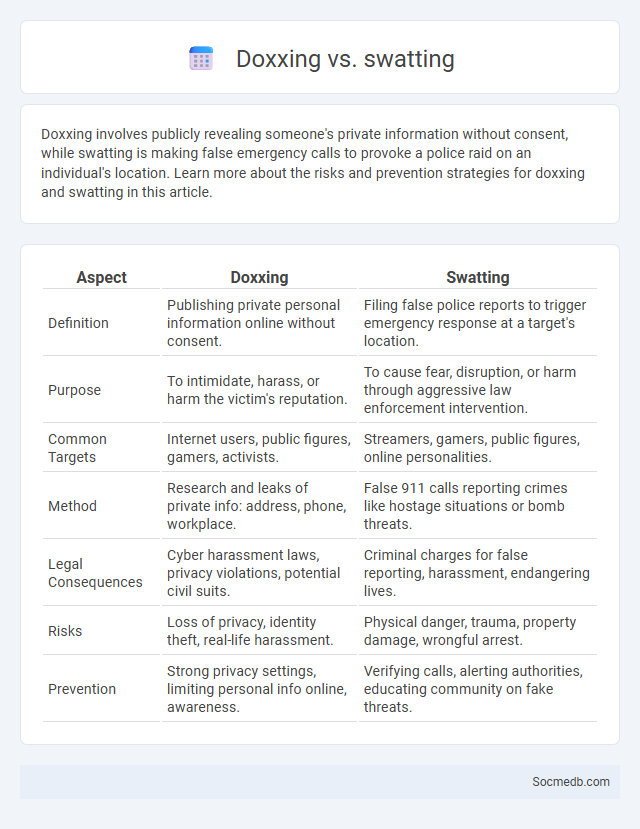
Photo illustration: doxxing vs swatting
Doxxing involves publicly revealing someone's private information without consent, while swatting is making false emergency calls to provoke a police raid on an individual's location. Learn more about the risks and prevention strategies for doxxing and swatting in this article.
Table of Comparison
| Aspect | Doxxing | Swatting |
|---|---|---|
| Definition | Publishing private personal information online without consent. | Filing false police reports to trigger emergency response at a target's location. |
| Purpose | To intimidate, harass, or harm the victim's reputation. | To cause fear, disruption, or harm through aggressive law enforcement intervention. |
| Common Targets | Internet users, public figures, gamers, activists. | Streamers, gamers, public figures, online personalities. |
| Method | Research and leaks of private info: address, phone, workplace. | False 911 calls reporting crimes like hostage situations or bomb threats. |
| Legal Consequences | Cyber harassment laws, privacy violations, potential civil suits. | Criminal charges for false reporting, harassment, endangering lives. |
| Risks | Loss of privacy, identity theft, real-life harassment. | Physical danger, trauma, property damage, wrongful arrest. |
| Prevention | Strong privacy settings, limiting personal info online, awareness. | Verifying calls, alerting authorities, educating community on fake threats. |
Understanding Doxxing: Definition and Implications
Doxxing refers to the malicious act of publicly revealing private or identifying information about an individual on social media platforms without their consent. This practice can lead to severe psychological distress, harassment, identity theft, and potential threats to personal safety. Understanding doxxing is crucial for developing effective digital privacy strategies and promoting safer online environments.
What Is Swatting? Methods and Risks
Swatting is a dangerous harassment tactic where attackers make false emergency calls to provoke a police SWAT team response at an unsuspecting victim's location. Common methods include fake hostage situations, bomb threats, or violent incidents reported through spoofed phone numbers or hacked accounts to deceive dispatchers. The risks of swatting are severe, involving potential physical harm from armed law enforcement, psychological trauma, legal consequences, and the misuse of emergency resources.
Personal Information Doxxing Explained
Personal information doxxing involves maliciously exposing your private data such as home address, phone number, or financial details on social media platforms without consent. This practice endangers your privacy, leading to harassment, identity theft, or even physical harm. Protecting your personal information through strict privacy settings and cautious sharing is essential to avoid the risks associated with doxxing.
Key Differences: Doxxing vs. Swatting
Doxxing involves publicly sharing someone's private information without consent, leading to potential harassment or identity theft, while swatting entails making a false emergency report to dispatch armed law enforcement to a victim's location, creating immediate danger and legal consequences. Both acts violate personal security but differ in execution and impact; doxxing targets online privacy, whereas swatting risks physical harm. Understanding these distinctions helps you protect your digital safety and respond appropriately to threats on social media platforms.
How Doxxing and Swatting Overlap
Doxxing and swatting overlap through the use of personal information to escalate harassment into dangerous real-world consequences. Doxxing involves publicly revealing private details, which swatters exploit to falsely report emergencies, prompting armed police responses to victims' locations. This intersection highlights the critical need for privacy protection and law enforcement strategies to mitigate risks associated with online threats.
The Motivations Behind Doxxing and Swatting
Doxxing and swatting are driven primarily by motives such as revenge, intimidation, and the desire for social power within online communities. Perpetrators often aim to expose private information or provoke dangerous police responses to silence or harass their targets, exploiting vulnerabilities in digital privacy and emergency response systems. Understanding these motivations is essential for developing robust cybersecurity policies and law enforcement protocols that protect individuals from such malicious social media behaviors.
Legal Consequences of Doxxing and Swatting
Doxxing involves publicly revealing someone's private information without consent, leading to severe legal consequences including charges of harassment, invasion of privacy, and cyberstalking. Swatting, the act of falsely reporting emergencies to dispatch armed law enforcement to an unsuspecting person's location, carries criminal penalties such as felony charges, heavy fines, and potential imprisonment. Understanding these serious offenses helps you protect your digital presence and avoid actions that could result in long-lasting legal repercussions.
Protecting Yourself from Online Harassment
Protecting yourself from online harassment involves utilizing privacy settings on social media platforms such as Facebook, Instagram, and Twitter to restrict unwanted interactions and control who sees your content. Reporting and blocking abusive users through platform-specific tools helps mitigate exposure to harmful messages and cyberbullying. Maintaining strong, unique passwords and enabling two-factor authentication enhances account security, reducing the risk of unauthorized access or identity theft.
Reporting Doxxing and Swatting Incidents
Reporting doxxing and swatting incidents on social media platforms is crucial for ensuring user safety and preventing cyber harassment. Users should immediately utilize platform-specific reporting tools to flag such content, providing detailed evidence like screenshots, URLs, and timestamps to expedite investigation. Social media companies often collaborate with law enforcement agencies to address these threats effectively while implementing stricter community guidelines and proactive monitoring systems.
Building a Safer Digital Community
Promoting respectful interactions and enforcing clear community guidelines are essential to building a safer digital community. You can protect personal information by using strong privacy settings and reporting harmful content promptly. Empowering users with educational resources on digital literacy fosters a positive online environment for everyone.
 socmedb.com
socmedb.com